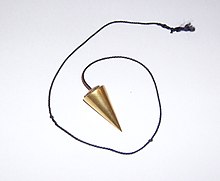Sidereal pendulum
The sidereal pendulum (from Latin sidereus , to: sidus = star (picture) : related to the stars and Latin : pendere = to hang) corresponds structurally to a plumb line . It is a tool of radiesthesia and other esoteric teachings that is used to attempt to obtain certain information. According to the user's imagination, this can be used to make unconscious content visible. However, the process is neither scientifically verifiable nor empirically proven.
use
The starting point of commuting is always a question , with a positive, negative or neutral answer being sought. The pendulum can turn left or right, or it can swing back and forth on a line. Which movement represents which answer can be individually determined and can even change from pendulum session to pendulum session. According to the users, esoteric pendulums are "calibrated" before use in order to know how the result is to be interpreted. However, this calibration is not a scientifically or technically traceable procedure, as is the case with measuring systems, for example.
A typical pendulum consists of an approximately 2-3 cm long conical metal body and a 20 cm long cord. Different pendulum shapes are used by radiesthesists. For example, drop pendulum , isispendulum , pearl pendulum, resonance pendulum or triangle pendulum, each of which is named after the shape or special characteristic of the pendulum object.
The material used for the pendulum is mostly brass and copper , followed by precious stones . Instruments made of wood or precious metals are less common . Many users have different pendulums for different tasks. Some users attribute special properties to pendulums of certain manufacturing methods (e.g. machine-made pendulums are considered less favorable). It is assumed here that certain subtle information flows in during production , which have a qualitative influence. Some esotericists discuss their pendulum before using it. None of these properties or methods have a scientifically sound background.
One of the most prominent commuters in German-speaking countries was Anton Stangl, from Rothenberg in the Odenwald, who brought the topic of radiesthesia to the public through his numerous publications, seminars and lectures .
Possible explanation of the phenomenon
The tendency of the pendulum in the direction of a certain response can be explained with the Carpenter effect . In this case, it is sufficient if the commuter wants the pendulum to go in a certain direction. As a result, imperceptibly small muscle movements bring the pendulum in the desired direction without the commuter having to consciously give the push.
The majority of studies speak against the use of commuting in complementary medical diagnostics.
literature
- Ansha: Basic course commuting. An old tradition revived. Verlag Ludwid, Munich 2001 (4th edition), ISBN 3-7787-3754-6 .
- Bernd Harder : The supernatural phenomena in the test. Pattloch Verlag, Augsburg 1996, ISBN 3-629-00698-1 .
- Wolfgang Hund: Does that really exist? Occultism and esotericism in questions and answers. A guide for school and youth work. Commuting, backing glasses, healing hands. Care-Line, Neuried 2004, ISBN 3-937252-15-0 .
- Georg Kirchner: pendulum and divining rod. Manual of modern radiesthesia (= Knaur 4127 Esoteric ). Full paperback edition. Droemer Knaur, Munich 1985, ISBN 3-426-04127-8 .
- Anton Stangl: The Great Pendulum Book. Ansata Verlag, 2003, ISBN 978-3778772515 .
Individual evidence
- ^ [1] Der Pendler aus dem Odenwald, Frankfurter Allgemeine Zeitung, January 3, 2014. Accessed October 20, 2016
- ^ Edzard Ernst : Complementary medical diagnostic procedures. Dtsch Arztebl 2005; 102 (44): A-3034 / B-2560 / C-2410
